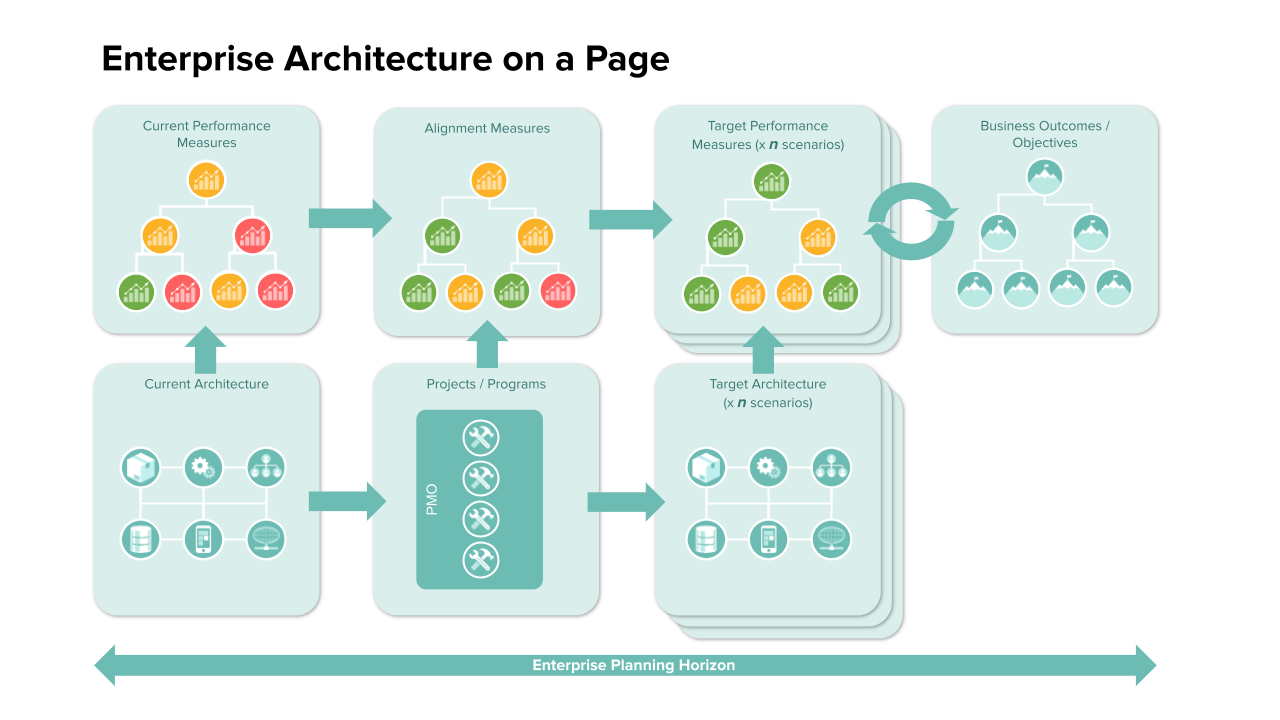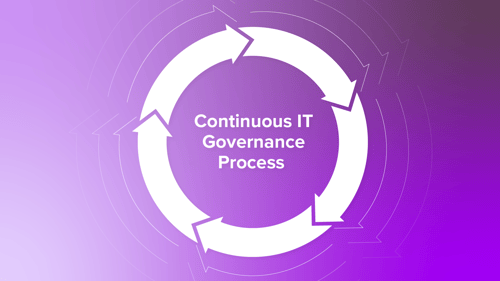Mature Enterprise Architecture teams are the bridge builders between business and IT, strategy and execution, the complex to the consumable. Even so, communicating the value of Enterprise Architecture, especially to those without a background in EA, can be challenging.
Showing your stakeholders the Zachman Framework or the TOGAF Architecture Development Method (ADM) may only make things worse - while they articulate what Enterprise Architecture does, they often struggle to articulate why it matters.
When I started working as an enterprise architect, I found myself drawing the same picture, again and again, to help explain exactly that. While I've refined it over the years, the basics have stayed the same.
Not only does it resonate with a non-technical audience, but it's also a good way for architects to check their architectures have all the elements they need.
Below I'll take you through each aspect of the diagram--the EA 101--and how you can effectively communicate it to your executives or other stakeholders.
Getting Control of the Here and Now
The 101 Breakdown
We start by modeling the organization as it exists today – the Current (or As-Is) architecture, at the bottom left.
Architects do this by building models of the different dimensions of the organization – products, processes, departments, data, applications, networks, and more – and linking them together.
This series of linked models represents an enterprise architecture – our best view of the whole organization at this particular point in time. However, this architecture doesn’t always tell enough of a story. The organization needs to understand its current performance (top left).
Performance can be measured using metrics such as KPIs (Key Performance Indicators) or KRIs (Key Risk Indicators). A balanced view of performance will look at it through multiple lenses - such as financial (cost, revenue), risk, agility or time-to-market, and employee or customer satisfaction.
The key here is that these two models are twinned – the architecture has measurable performance, and the performance is (at least in part) a characteristic of the architecture.
So changing the architecture should also change its performance.
Communicating the Value of Enterprise Architecture
“Architects can provide the data-driven As-Is overview of the whole ecosystem, linked to metrics, that enable stakeholders to know with confidence what they need to meet their objectives.”
Measuring The Aiming Point
The 101 breakdown
Now let’s move up to the top-right box in our diagram: Business Outcomes or Objectives.
Where your organization is today isn’t necessarily where it wants to be. It has a strategy – to move into new markets, or reduce operating costs, or improve the services it provides to its community.
Any worthwhile strategy should be measurable by one or more objectives. Ideally, these should be expressed on the same basis as the measure you use to track performance - so the cost, risk, time-to-market, and customer satisfaction, and so on.
Now assuming that there’s a gap between the two, meeting those objectives means changing the organization.
How do we do that? By changing the architecture.
“Once we have the As-Is, architects enable stakeholders to confidently measure one or more objectives with the exact knowledge of how far we are from delivering them.”
Getting to Where We Want to Be
The 101 breakdown
Let’s look at the Target (or To-Be) state of the architecture - the bottom right of the picture.
Our target architecture may introduce new systems and processes, process new data, offer new products or change the organization structure (that last one is almost guaranteed!).
Even if the parts are different, the methods you use to model this future organization are exactly the same as the one you use to model your current organization.
Just as you measure your current architecture to understand its performance, you measure your target architecture to project its performance using those same measures of cost, risk, time-to-market, and customer satisfaction. By comparing this projected performance to your organization’s objectives, you can understand and evidence how your target architecture supports business strategy.
“Architects are able to bridge the gap between the As-Is of the organisation to its objects with an actionable and measurable roadmap.”
Controlling for Many Futures
The 101 breakdown
Of course, the future is highly uncertain. Strategic priorities - and therefore, objectives - can change, and fast. Having only one target architecture may not be enough.
Alternative target architectures are called scenarios. They can be optimized for different objectives or business outcomes - for example, one for growth, one for cost optimization, one for risk reduction, and so on. Each scenario will carry a different tradeoff between key performance measures based on a different business priority.
The job of the enterprise architect is to clearly articulate these tradeoffs to their audience to drive decisions about the shape of the target.
“Since the roadmap is always in flux, architects can enable the constant recalculation of strategies and propose multiple solutions with precise understanding of their tradeoffs.”
The Engines of Change
The 101 breakdown
Once you have an agreed target architecture, it might feel like the job is done.
Unfortunately, the architecture doesn’t magically transform itself from one state to another. Doing that requires something else: Change.
Projects - be they Agile teams or waterfall programs - are the engines of transformation, so understanding your change portfolio or backlog is essential.
Each project or program can be mapped, showing how it impacts the current architecture and transforms it into the target by adding, removing, or changing elements - processes, systems, and information. Projects must also be measured for performance, but the measures are a little different this time.
Here, we do not measure organizational performance but whether or not those projects are on-track and aligned to strategy. Tracking these alignment measures is how we ensure the benefits our roadmaps promise are actually delivered.
“Alignment is a constant process and architects provide a continuous recording and analysing of where we are (in relation to where we want to be).”
Communication: The Most Important Skill in the EA Toolbox
This picture isn’t a formalized framework or an approved standard. It’s what we call a marketecture - a picture that prioritizes communication over technical accuracy.
Next time you’re called on to explain what it is the enterprise architect does, try quickly stepping your audience through it.
If they nod, then it has done its job.
As the bridge builder across teams, communication is the number one skill of the EA in enabling successful change in their organization. Engagement-focused tooling like Ardoq makes this just as much a “hard skill” as a “soft skill” - and to succeed, you need both.
We’re already helping businesses like yours transform how they communicate the value of Enterprise Architecture. Request a demo today:
 Edward Granger
With over 20 years of experience in the industry,
Ed Granger is at the forefront of driving innovation and has a strong belief that for EA to control Digital, it must be Digital.
Edward Granger
With over 20 years of experience in the industry,
Ed Granger is at the forefront of driving innovation and has a strong belief that for EA to control Digital, it must be Digital.




/Logos/Ardoq/RGB_Ardoq_Logo_Stacked_White_Monochrome%201.png?width=80&height=77&name=RGB_Ardoq_Logo_Stacked_White_Monochrome%201.png)

